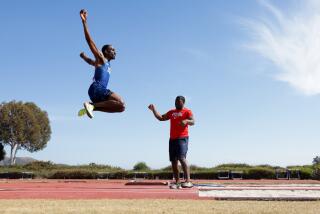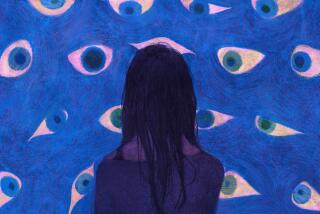OC HIGH / STUDENT NEWS & VIEWS : Those Who Cannot See Find Ways to Adapt : Activities: Through the use of Braille, computers and audio tape, visually impaired teens can pursue a range of interests.
Scott Blanks, 17, is a chess player, music fan and honors student at Anaheim High School. From promoting the chess club he and another student founded to pursuing an interest in guitar, Blanks is by any standard an extremely active teen-ager.
He is also blind.
Though visual impairment can drastically alter life, adaptive techniques allow for Blanks and other teens to participate in a wide range of activities.
At the Orange County Braille Institute in Anaheim, classes range from adaptive cooking to country line dancing to gardening. Blanks is a member of the Braille Institute Youth Group, which offers activities that include rock-climbing and surfing and classes to promote self-esteem as well as personal skills.
Blanks is one of seven visually impaired students at Anaheim High, which has had a visually handicapped program for about 30 years.
âAnaheim (high school) has a class where (texts) can be put into Braille. There is a lot of equipment and technology . . . so itâs not as hard as people think,â Blanks said. A computer class is held for the visually impaired so students can learn on a special type of computer.
Blanks, who has honors classes in U.S. history and English, studies with the help of textbooks in Braille and materials on tape. âTape takes up less space. Braille is a lot bulkier, but when reading Braille, you can just go to the page and find (what youâre looking for).
âWhen you first learn (Braille), you learn each letter and each number. Braille is a lot bigger than print, and they have contractions to write more in less space,â said Blanks, who began learning to read Braille at age 3.
He was born with glaucoma, which can damage the optic nerve. âThey said I could see for a few months, and then it went away totally,â he said.
âI do things people might not think Iâm able to do, like shooting baskets, and I like a lot of TV shows,â Blanks said. âWhen youâre born blind . . . thatâs the way youâre used to having things. . . . Itâs much harder for people who werenât born blind,â Blanks said.
*
Those who lose their sight after having had vision usually find it a difficult transition. The modification of life varies with each person.
âIt depends a lot on their background,â said Marajean Davis, a counselor at the Orange County Braille Institute in Anaheim. âSometimes itâs trust . . . because they no longer have vision to confirm things. Giving up and letting go of who you are and how you did things . . . learning the new you. Some people think theyâre going to get their sight back. Denial is a thing they have to overcome.â
One Anaheim student who lost her eyesight described her experience this way: âI was such a visual person, so itâs harder to make that adaptation to sound,â she said.
âI like to know about colors and the setting around me or on TV. I miss seeing peopleâs expressions. I miss not being able to read and write. It was a hard adjustment,â she said.
Losing oneâs sight is often similar to the grieving process after losing a person to death, according to Davis.
Usually the first emotion is plain shock, followed by denial, depression or anger. âThen it comes time when they start to learn or accept their loss,â Davis said. âAccepting doesnât mean liking it . . . they have to accept its reality, which means coping.â
Small things they once took for granted, such as nonverbal cues between people, are lost, making communication more strenuous.
Davis has seen âvery few people who havenât really lost a lot of self-esteem when they lost their sight.â
If dealing with vision loss, Davis says, âGive yourself permission to grieve your loss. Youâre not crazy because you want to cry or be depressed or angry. Find positive ways to get rid of your anger. If you donât go through that grieving process, you postpone it, and it can build up.â
*
Because there are so many misconceptions, those unfamiliar with blindness are sometimes uncomfortable or afraid around a visually impaired person.
âTo overcome a fear, you need to experience it. The visually impaired person isnât contagious,â Davis says.
One common assumption is that the person lives in darkness. However, only 10% of the visually impaired are totally blind. âNinety percent of those classified as blind have light perception of some kind and have some kind of vision,â Davis says.
Even if the first thing a seeing person notices about them is their use of a guide dog or white cane, the visually impaired want to be known as people first, not as being blind.
âBlind people are people, like everyone else,â Blanks said.
âThey have all the problems of other people, all the feelings and capabilities. Weâre not a different race; weâre just like everyone else!â
Davis adds: âWhen we say âa blind person,â we take away from their person-hood. It points out their disability before the person.â
The Anaheim student who is dealing with the loss of her sight said she wishes that there could be more training in how to treat the visually impaired.
âIn my experiences, places like hospitals donât know what to do because they donât come across visually impaired people very often. Therefore, we arenât helped the way we should be. We are either ignored or spoken to loudly,â she said.
âPeople should remember that we could do just about anything anyone else would do. It may just take us a little longer . . . itâs all in (our) attitude.â
More to Read
Sign up for Essential California
The most important California stories and recommendations in your inbox every morning.
You may occasionally receive promotional content from the Los Angeles Times.










